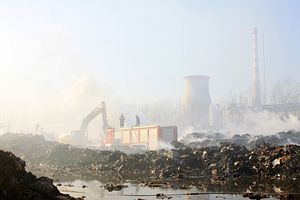Last week, China announced that it would be launching a 50 billion RMB ($8.13 billion) environmental protection fund to curb pollution. Funds take the form of low or no-interest loans from the National Development and Reform Commission and the Ministry of Finance to critical industries. Although these industries have not yet been specified, analysts anticipate funds going, at least in part, to the water treatment industry. This policy is viewed as a market-based solution to environmental protection since it will boost the role of pollution treatment industries.
The fund is part of the administration’s “War on Pollution” declared by Premier Li Keqiang earlier this year. This is a war fought on many fronts. Some solutions implemented this year include installing pollution controls on coal-fired plants, eliminating some high-polluting plants, and altering requirements for particulate matter reduction. These latter solutions are not market based. Viewed together, a multi-pronged environmental protection scheme that includes both market-based and non-market based solutions is essential to reduce carbon emissions and other pollutants.
First, a market-based solution that channels funds to pollution-fighting industries will help to stimulate much-needed growth. Promotion of the water and possibly the waste gas industries via the environmental protection fund will result in both cleaner resources and GDP generation. Trial carbon emissions trading programs have also been under way in seven cities, although Beijing’s program is the only one that requires annual absolute emission reductions for companies in the manufacturing and service sectors. Market-based solutions are often viewed by economists as first-best solutions to pollution externalities, since they align incentives among public and private actors to reduce pollution using price signals.
Second, non-market based solutions that regulate pollution are also essential in curbing some of the worst practices, as markets cannot prevent all polluting behavior. For example, the Airborne Pollution Prevention and Control Action Plan introduced in May of this year required the Yangtze River Delta and the Pearl River Delta to reduce coal use by 2017. Under this plan, the greater Beijing area must reduce particulate emissions by 2017, while Liaoning and Jilin must restrict growth of coal use to less than 2 percent by 2017. Restrictions on coal emissions implemented this year, mentioned above, will require companies like China Huaneng Group, which owns 14% of China’s coal power fleet, to spend at least $1.61 billion this year alone to implement desulfurization and dust removal equipment. Non-market based solutions—in this case, regulation, often referred to as “command and control,” is necessary where the market is incomplete; in China’s case, the coal market is controlled to a large extent by the government.
A major problem in carrying out these policies is the reluctance or refusal of major corporations to comply with environmental protection policies. PetroChina, one of the largest state-owned enterprises, owed 800 million RMB in fines to the city of Yanan in Shaanxi Province as of January 2014. If state-owned enterprises cannot be forced to comply with environmental regulations, the state’s war on pollution may well be in jeopardy. China has extensive environmental regulations on its books; the problem has been enforcing them.
Meanwhile, additional steps must be taken to bolster environmental protection. While prices of some resources have been allowed to somewhat better reflect market forces, prices of critical resources, particularly fossil fuels, continued to be controlled in many ways. For example, in 2012, via the revised Natural Gas Utilization Policy, natural gas prices were allowed to rise to reflect increased seasonal demand and to be interrupted with the use of alternative fuels. At the same time, the number of sectors receiving preferred (lower) prices expanded, preventing market forces from truly determining natural gas prices. Similarly, oil and electricity prices are subsidized. Electricity prices are priced by type of end user and do not reflect costs directly. Allowing prices to fluctuate would permit power plants to pass on the real cost of production to consumers, encouraging demand-side electricity conservation.
China has a tough path ahead in its war on pollution, although progress is being made. Loan allocations to environmental protection sectors via the environmental protection fund are an important component of environmental initiatives. Additional market-based solutions, non-market based solutions, and reduced subsidies to dirty fuel and electricity sectors will be needed if China is to successfully reduce its environmental footprint.

































